Table of Contents
A compound microscope is a class of optical or light microscope. I have already discussed about basics of a microscope on my previous note “Parts of Microscope with their Functions and Working Principle”, you can check them to get an idea about from which class compound microscope belongs and what is a microscope, and more. It is a type of high quality microscope. All good quality microscopes have achromatic, parcentered, parfocal lenses.
Before Jump into it follow my previous note on Microscope. I have also discussed about Simple Microscope in my previous note “Simple Microscope: Working Principle, Uses, Parts, and their Functions” which is also a class of optical microscope.
What is a Compound Microscope? – Compound light microscope definition
A compound microscope is a type of microscope that uses lenses and light to magnify objects. It consists of two main parts: the objective lens, which is located near the object being viewed, and the eyepiece, which is located near the viewer’s eye. The objective lens is typically composed of multiple lenses that work together to magnify the image, while the eyepiece contains a single lens that further magnifies the image for the viewer. Compound microscopes are used in a variety of settings, including scientific research, education, and industry, to observe and study small objects or organisms that are too small to be seen with the naked eye.
A microscope with excellent resolution and two sets of lenses that produce a two-dimensional image of the specimen.
Compound lens refers to the use of multiple lenses in a microscope. In addition, the compound microscope is one of the optical microscope types. The second form of optical microscope is a straightforward microscope. The difference between a simple microscope and a compound microscope is that the former employs a single lens while the latter employs multiple lenses.
According to legend, Zacharias Janssen, a Dutch spectacles maker, invented the compound microscope in the early 1590s. However, there is no evidence that Zacharias Janssen utilised this microscope.
Types of Compound Microscope
Classification of Compound Microscope
Compound Microscope is classified in two categories;
A. Light Microscope
Light Microscope is further classified into four categories such as;
- Bright-Field Microscope: This is the most common type of microscope used in laboratories. It uses a bright field illumination technique to produce a dark image of an object against a bright background. It is used for observing stained biological samples, tissues, and cells.
- Dark-Field Microscope: This microscope produces a bright image of an object against a dark background. It uses a special illumination technique that causes light to scatter, making the object appear bright. It is used for observing live, unstained samples, such as bacteria or small organisms.
- Phase-Contrast Microscope: This microscope is used to observe transparent samples that do not absorb or scatter light, such as living cells or microorganisms. It uses a special phase-contrast technique to produce an image of the object, enhancing the contrast between the object and the background.
- Fluorescent Microscope: This microscope uses a special light source to excite fluorescent molecules in the sample, producing a bright image of the sample against a dark background. It is used to observe fluorescently labeled samples, such as cells, tissues, or proteins.
B. Electron Microscope
Electron Microscope is further classified into three categories such as;
- Scanning Electron Microscope (SEM): This type of microscope produces highly detailed images of the surface of a specimen using a focused beam of electrons. The beam scans the surface of the specimen, and the reflected electrons are used to produce a detailed 3D image.
- Transmission Electron Microscope (TEM): This type of microscope uses a beam of electrons that passes through a thin section of the specimen to produce an image. It provides high resolution, detailed images of the internal structure of cells, tissues, and other biological samples.
- Confocal Microscope: This type of microscope is used to produce 3D images of the specimen. It uses a laser beam to scan the specimen at different depths, and a computer generates a 3D image of the specimen from the collected data. Confocal microscopy is commonly used in neuroscience, cell biology, and other fields to study the structure and function of cells and tissues.
Compound microscopes are further subdivided into various different types of microscopes that vary in their optical configurations, price, and intended purpose.
Working Principle of Compound Microscope
Compound microscopes feature a combination of lenses that improves both magnification and resolution.
Typically, the specimen or object to be examined is affixed on a transparent glass slide and positioned between the condenser lens and objective lens on the specimen stage. A condenser lens concentrates visible light from the base onto the specimen.
The objective lens collects the light transmitted by the specimen and produces a magnified image of the specimen, known as the primary image, within the body tube. This image is once again magnified by the eyepiece or ocular lens. When higher magnification is required, the snout piece is rotated to align the objective of a higher magnification (typically 45X) with the illuminated portion of the slide.
On occasion, extremely high magnification is required (for instance, when observing a bacterial cell). In this instance, a 100X oil immersion objective lens is utilized. The common light microscope is also referred to as a bright-field microscope due to the fact that it produces an image within a vividly lit field. Because the specimen or object is denser and more opaque than its environs, the image appears darker. Light passing through an object is partially absorbed.
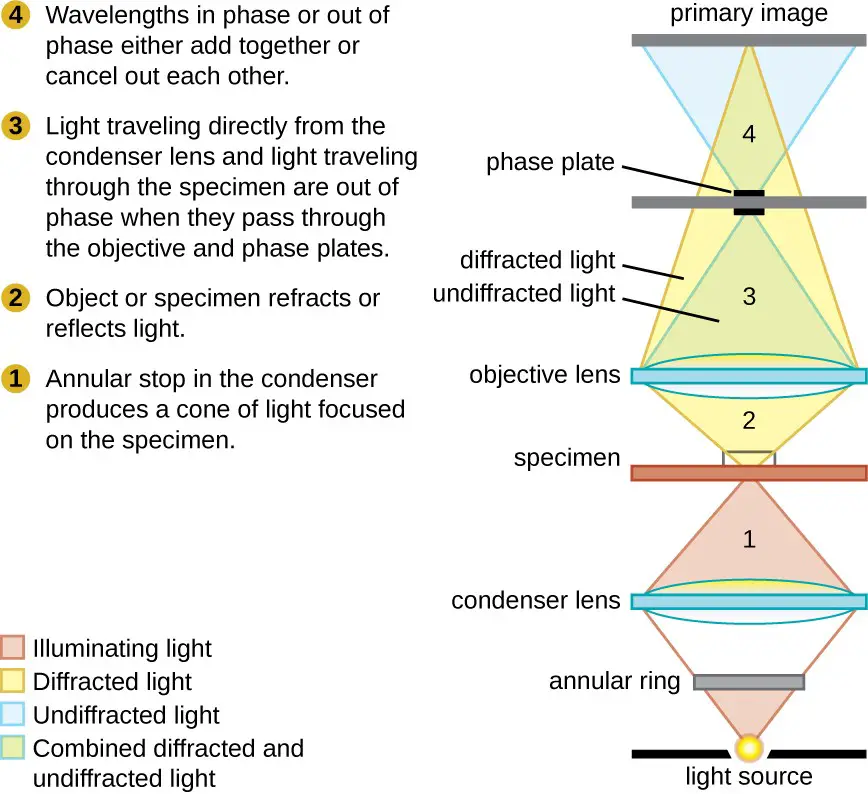
As depicted in figure, the lens closest to the object is known as the objective, and it produces a genuine, inverted, magnified image of the object. The subject of the second lens is this image. The lens used to view the final image is referred to as an ocular, and it functions as a simple microscope or magnifier. It generates an image that is magnified and virtual. As depicted in the figure, when the final image is formed at a near point, the first inverted image will be within focal distance.
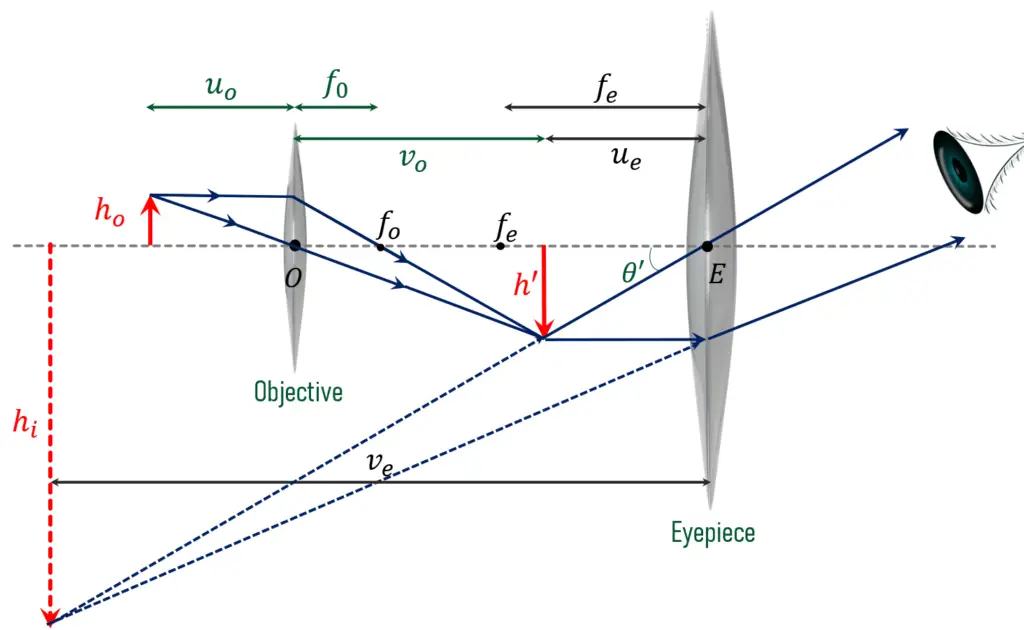
The first inverted image will be at focal distance when the final image is formed at infinity.
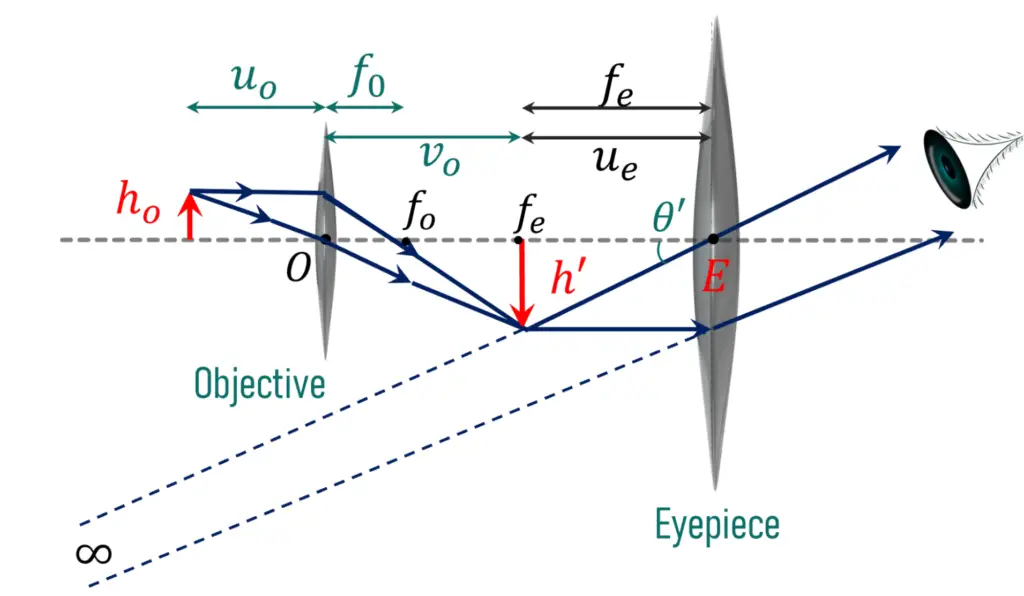
The final image is flipped relative to the original object. Let’s now obtain the magnification a compound microscope provides.
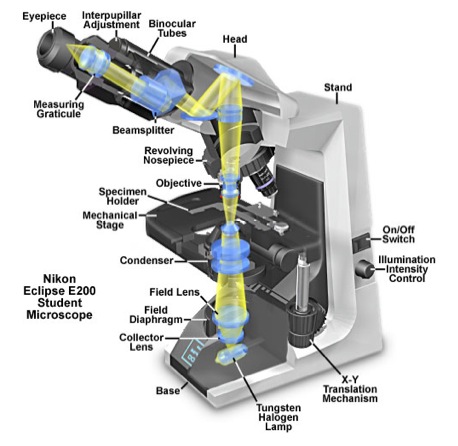
Mechanism of Compound Microscope
Compound microscopes create a sharp image of specimen by these following steps;
- First of all, a specimen is placed between the objective and condenser lens.
- The light emitted from the light source is pointed over the specimen with the help of a condenser lens.
- After that, the light is passed through the specimen and comes towards the objective lens.
- The objective lens captures the light coming from the specimen and creates a magnified image of the specimen, which is called the primary image.
- Then the objective lens passed this image through the body tube to the ocular lens or eyepiece and again magnifies the image.
- At last, the viewer can see a clear and magnified image of the specimen through the eyepiece.
- Occasionally or during the use of a 100x objective lens oil immersion method is used to produce a highly magnified sharp image of the specimen. In this method, a drop of immersion oil is placed between the objective lens and specimen slide.
Magnification Power of Compound Microscope
To get the overall magnification when viewing an image with a compound light microscope, multiply the objective lens power, which is commonly 4x, 10x, or 40x, by the eyepiece power, which is typically 10x.
A 10x eyepiece combined with a 40x objective lens will provide a 400x magnification. The naked eye can now observe the specimen at 400 times greater magnification, revealing minute features.
Alternately, the magnification of the compound microscope can be calculated as follows:
m = D/ fo * L/fe
where, D = Least distance of distinct vision (25 cm)
L = Length of the microscope tube
fo = Focal length of the objective lens
fe = Focal length of the eye-piece lens
Parts of Compound Microscope
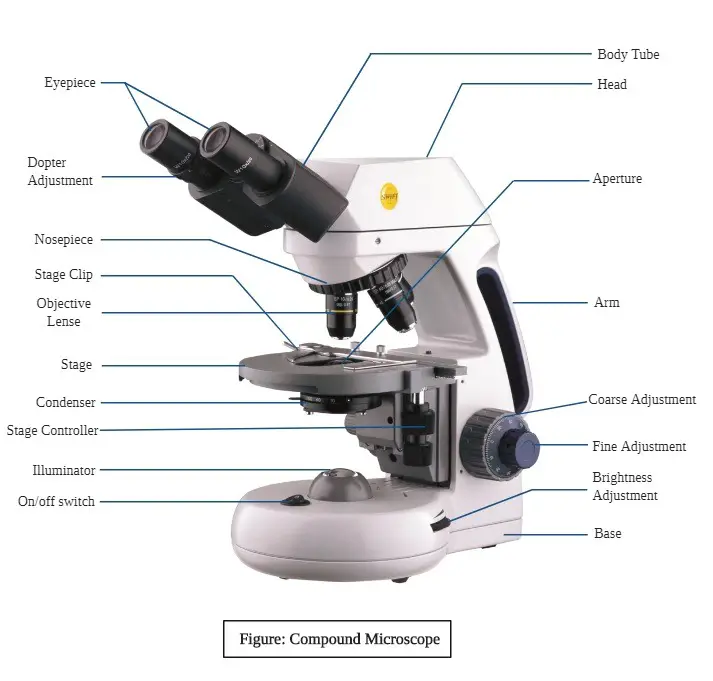
Non-Optical Parts of Compound microscope
1. Microscope Head
- The head of a compound microscope is the part that holds the eyepieces and the objective lenses. It is typically mounted on a stand or arm that allows it to be adjusted for the height and comfort of the user.
- The eyepieces are the lenses that the user looks through to view the sample. They are usually adjustable to allow for fine-tuning of the focus and magnification.
- The objective lenses are the lenses that are closest to the sample and are used to magnify the image. Compound microscopes typically have multiple objective lenses that can be swapped out to change the magnification of the microscope. The most common objective lens magnifications are 4x, 10x, 40x, and 100x.
- Other parts of a compound microscope may include a stage (the platform on which the sample is placed), a focus mechanism (for adjusting the distance between the objective lenses and the sample), a light source (for illuminating the sample), and a condenser (for focusing the light onto the sample).
3. Body Tube
The body tube of a compound microscope is the part that connects the eyepieces to the objective lenses and holds them in place. It is typically a long, narrow tube that extends from the top of the microscope head (where the eyepieces are located) down to the stage (the platform on which the sample is placed).
The body tube serves several important functions:
- It allows the eyepieces and objective lenses to be aligned with each other, which is necessary for the microscope to produce a clear and focused image.
- It allows the eyepieces and objective lenses to be moved relative to each other, which is necessary for focusing the microscope. This is typically done using a focus mechanism located near the base of the microscope.
- It helps to protect the eyepieces and objective lenses from damage and contamination.
- It helps to ensure that the light from the light source is properly directed onto the sample.
The body tube is typically made of metal or plastic and is designed to be durable and lightweight. It may also have features such as markings or scales to aid in focusing the microscope and measuring the sample.
4. Nose piece
The nose piece of a compound microscope is the part that holds the objective lenses and allows them to be rotated and swapped out. It is typically located near the base of the microscope and consists of a circular mount with one or more objective lenses attached to it.
The nose piece serves several important functions:
- It allows the user to change the magnification of the microscope by rotating the objective lenses into position. This is typically done by turning a knob or lever located on the side of the nose piece.
- It helps to protect the objective lenses from damage and contamination.
- It helps to ensure that the objective lenses are properly aligned with the sample and the eyepieces.
The nose piece is typically made of metal or plastic and is designed to be durable and easy to use. It may also have features such as markings or scales to aid in focusing the microscope and measuring the sample.
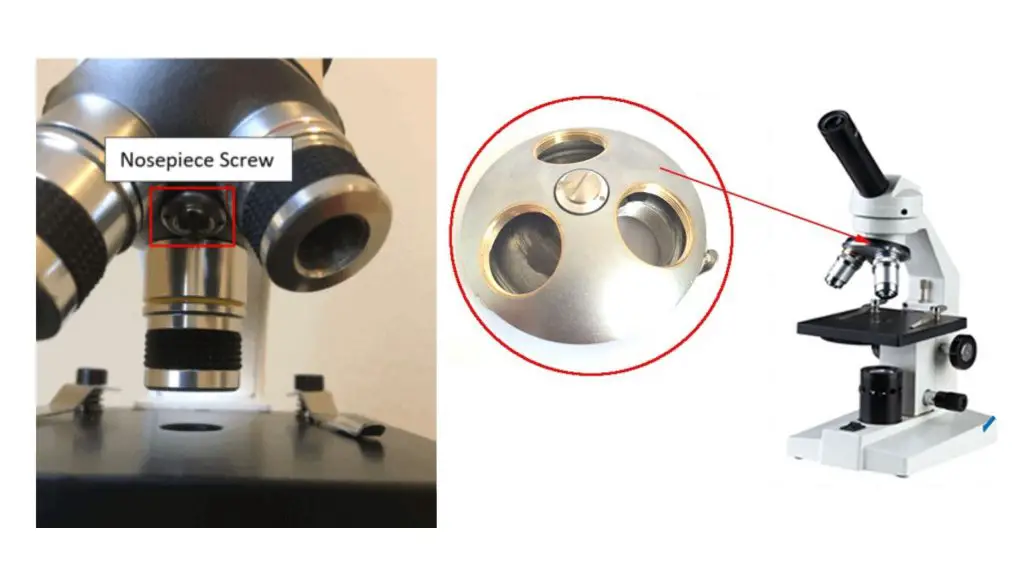
6. Mechanical Stage
The mechanical stage of a compound microscope is a platform that is used to hold the sample and move it into position for viewing. It is typically located below the objective lenses and is used to precisely position the sample so that it is centered under the objective lenses.
The mechanical stage consists of a flat, rectangular platform that is mounted on a pair of x-y axes. The sample is placed on the platform and held in place by a sample holder or stage clip. The stage can then be moved horizontally (left and right) and vertically (up and down) using a pair of knobs or levers.
The mechanical stage serves several important functions:
- It allows the user to precisely position the sample under the objective lenses for viewing.
- It helps to protect the sample from damage and contamination.
- It helps to ensure that the sample is properly illuminated by the light source.
The mechanical stage is typically made of metal or plastic and is designed to be durable and easy to use. It may also have features such as markings or scales to aid in focusing the microscope and measuring the sample.
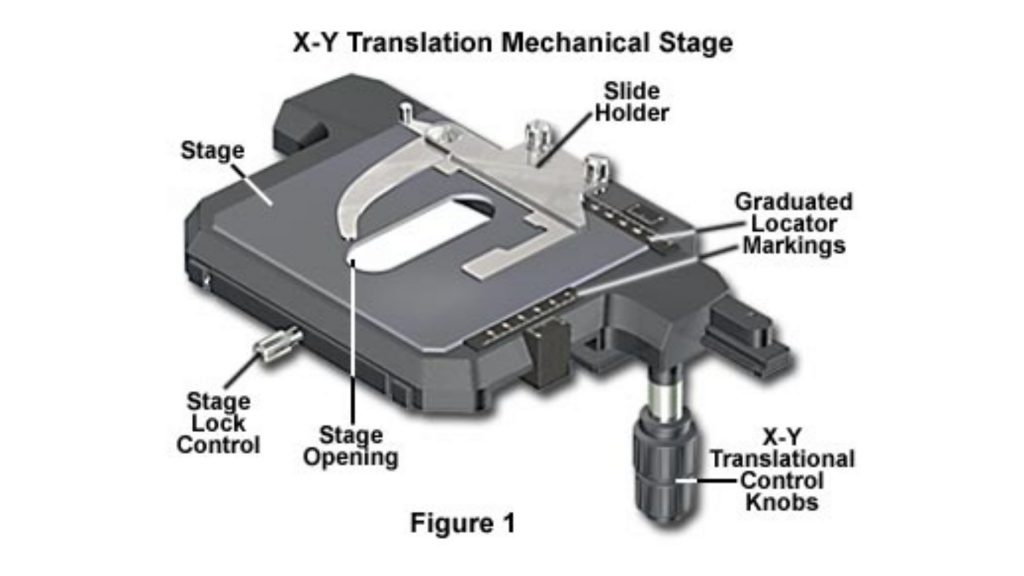
6. Stage Clips or Slide holder
Stage clips or slide holders are small devices that are used to hold the sample in place on the mechanical stage of a compound microscope. They are typically made of metal or plastic and are designed to clamp onto the edges of the sample or hold it in place using a spring-loaded mechanism.
Stage clips or slide holders serve several important functions:
- They hold the sample securely in place on the mechanical stage, which is necessary for precise focusing and observation.
- They help to protect the sample from damage and contamination.
- They help to ensure that the sample is properly positioned and aligned with the objective lenses.
There are several different types of stage clips or slide holders available, including ones that are designed to hold flat samples such as slides, and ones that are designed to hold irregularly shaped samples or samples mounted on a microscope stub. Some stage clips or slide holders may also have additional features such as markings or scales to aid in focusing the microscope and measuring the sample.
7. Base
The base of a compound microscope is the part of the microscope that sits on the surface and supports the rest of the microscope. It typically consists of a flat, stable platform that the microscope is mounted on and a set of legs or a stand that holds it in place.
The base serves several important functions:
- It provides a stable and level surface for the microscope to sit on, which is necessary for the microscope to function properly.
- It helps to keep the microscope upright and stable, which is important for the safety of the user and the integrity of the sample.
The base is typically made of metal or plastic and is designed to be durable and stable. It may also have additional features such as a light source or a power outlet for the microscope. The size and shape of the base will depend on the size and design of the microscope.
8. Arm
The arm of a compound microscope is the part of the microscope that connects the head to the base and holds it in place. It is typically a long, narrow rod or tube that extends from the base to the head of the microscope and is used to support the weight of the microscope and allow it to be adjusted for the user’s comfort and convenience.
The arm serves several important functions:
- It provides a stable and secure support for the head of the microscope, which is necessary for the microscope to function properly.
- It allows the head of the microscope to be adjusted for the user’s height and comfort, which is important for extended use of the microscope.
The arm is typically made of metal or plastic and is designed to be durable and stable. It may also have additional features such as markings or scales to aid in focusing the microscope and measuring the sample. The size and shape of the arm will depend on the size and design of the microscope.
9. Illuminator
The illuminator of a compound microscope is the part of the microscope that provides the light source for illuminating the sample. It is typically located below the stage and consists of a light source (such as a lamp or LED) and a focusing mechanism (such as a condenser or diaphragm) to control the intensity and distribution of the light.
The illuminator serves several important functions:
- It provides the light needed to properly illuminate the sample, which is necessary for the microscope to produce a clear and detailed image.
- It allows the user to control the intensity and distribution of the light, which is important for optimizing the image quality and minimizing glare or reflections.
The illuminator is typically located below the stage and is operated using a switch or control knob. The type of light source and focusing mechanism used will depend on the design of the microscope and the needs of the user.
10. Aperture
The aperture of a compound microscope is a small opening or hole that is used to control the amount of light that passes through the microscope. It is typically located in the light path between the light source and the sample and is used to adjust the brightness and contrast of the image.
The aperture serves several important functions:
- It allows the user to control the amount of light that reaches the sample, which is important for optimizing the image quality and minimizing glare or reflections.
- It helps to focus the light onto the sample, which is necessary for the microscope to produce a clear and detailed image.
The aperture is typically controlled using a diaphragm or iris located in the light path between the light source and the sample. It can be adjusted by turning a knob or lever or by using a lever or button on the microscope. The size of the aperture will depend on the needs of the user and the design of the microscope.
12. Iris diaphragm
The iris diaphragm of a compound microscope is a device that is used to control the amount of light that passes through the microscope. It is typically located in the light path between the light source and the sample and consists of a series of overlapping blades that can be opened or closed to adjust the size of the aperture.
The diaphragm or iris is a device positioned under the stage that may be adjusted to change the size and intensity of the cone of light projected through the slide.
By adjusting the size of this iris and moving the lens toward or away from the stage, it is possible to regulate the diameter and focal point of the cone of light that passes through the specimen.
The iris diaphragm serves several important functions:
- It allows the user to control the amount of light that reaches the sample, which is important for optimizing the image quality and minimizing glare or reflections.
- It helps to focus the light onto the sample, which is necessary for the microscope to produce a clear and detailed image.
The iris diaphragm is typically controlled using a knob or lever located on the microscope or by using a lever or button on the illuminator. The size of the aperture can be adjusted by opening or closing the blades of the diaphragm. The type of iris diaphragm and the focusing mechanism used will depend on the design of the microscope and the needs of the user.
13. On/off switch
- It is located at the base.
- This switch turns the illuminator off and on.
14. Stage Controller
A stage controller is a device that is used to control the movement of the mechanical stage on a compound microscope. It is typically located on the base of the microscope and consists of a joystick or other input device that can be used to move the stage left, right, up, or down.
The stage controller serves several important functions:
- It allows the user to precisely position the sample under the objective lenses for viewing.
- It helps to protect the sample from damage and contamination by allowing the user to move the sample out of the way if necessary.
- It helps to ensure that the sample is properly illuminated by the light source.
The stage controller is typically operated using a joystick or other input device that is located on the base of the microscope. The type of stage controller and the input device used will depend on the design of the microscope and the needs of the user. Some stage controllers may also have additional features such as markings or scales to aid in focusing the microscope and measuring the sample.
15. Brightness Adjustment
The brightness of a compound microscope can be adjusted by controlling the amount of light that reaches the sample. This can be done using a variety of methods, depending on the design of the microscope.
Some common methods for adjusting the brightness of a compound microscope include:
- Adjusting the intensity of the light source: The brightness of the image can be increased or decreased by adjusting the intensity of the light source. This is typically done using a control knob or lever on the illuminator or by adjusting the distance between the light source and the sample.
- Adjusting the aperture: The brightness of the image can be adjusted by controlling the size of the aperture, which is the opening through which the light passes. This can be done using a diaphragm or iris located in the light path between the light source and the sample.
- Adjusting the condenser: The brightness of the image can be adjusted by controlling the intensity and distribution of the light using the condenser. This is typically done using a control knob or lever on the condenser or by adjusting the distance between the condenser and the sample.
- Adjusting the eyepieces: Some eyepieces may have built-in diopter adjustments that allow the user to fine-tune the focus for their individual eyesight. This can help to improve the brightness and clarity of the image.
16. Diaphragm
A diaphragm is a device that is used to control the amount of light that passes through a microscope. It consists of a series of overlapping blades that can be opened or closed to adjust the size of the aperture, which is the opening through which the light passes.
The diaphragm serves several important functions:
- It allows the user to control the amount of light that reaches the sample, which is important for optimizing the image quality and minimizing glare or reflections.
- It helps to focus the light onto the sample, which is necessary for the microscope to produce a clear and detailed image.
- It helps to protect the sample from damage and contamination by limiting the amount of light that is exposed to the sample.
The diaphragm is typically controlled using a knob or lever located on the microscope or by using a lever or button on the illuminator. The size of the aperture can be adjusted by opening or closing the blades of the diaphragm. The type of diaphragm and the focusing mechanism used will depend on the design of the microscope and the needs of the user.
17. Fine adjustment
The fine adjustment knob of a compound microscope is a small knob or lever that is used to fine-tune the focus of the microscope. It is typically located near the base of the microscope and is used to make small, precise adjustments to the focus of the microscope.
The fine adjustment knob serves several important functions:
- It allows the user to make small, precise adjustments to the focus of the microscope, which is necessary for producing a clear and detailed image.
- It helps to protect the sample from damage and contamination by allowing the user to adjust the focus without having to touch the sample.
- It helps to ensure that the sample is properly aligned with the objective lenses.
The fine adjustment knob is typically used in conjunction with the coarse focus mechanism, which is used to make larger adjustments to the focus of the microscope. The fine adjustment knob is typically operated using a small knob or lever that is located near the base of the microscope. The type of fine adjustment knob and the focusing mechanism used will depend on the design of the microscope and the needs of the user.
18. Coarse adjustment
The coarse adjustment of a compound microscope is a mechanism that is used to focus the microscope by moving the objective lenses relative to the sample. It is typically located near the base of the microscope and consists of a knob or lever that is used to move the objective lenses up and down.
The coarse adjustment serves several important functions:
- It allows the user to focus the microscope by moving the objective lenses relative to the sample, which is necessary for producing a clear and detailed image.
- It helps to protect the sample from damage and contamination by allowing the user to adjust the focus without having to touch the sample.
- It helps to ensure that the sample is properly aligned with the objective lenses.
The coarse adjustment is typically used in conjunction with the fine adjustment knob, which is used to make small, precise adjustments to the focus of the microscope. The coarse adjustment is typically operated using a large knob or lever that is located near the base of the microscope. The type of coarse adjustment and the focusing mechanism used will depend on the design of the microscope and the needs of the user.
19. Diopter Adjustment
The diopter adjustment of a compound microscope is a mechanism that is used to fine-tune the focus of the eyepieces for the individual user’s eyesight. It consists of a small lever or dial that is located on the eyepieces and is used to adjust the focus for each eye separately.
The diopter adjustment serves several important functions:
- It allows the user to fine-tune the focus of the eyepieces for their individual eyesight, which is important for producing a clear and detailed image.
- It helps to ensure that the user can see the image clearly and comfortably, which is important for extended use of the microscope.
- It helps to protect the sample from damage and contamination by allowing the user to adjust the focus without having to touch the sample.
The diopter adjustment is typically operated using a small lever or dial that is located on the eyepieces. The user can adjust the focus for each eye separately by turning the lever or dial until the image appears clear and sharp. The type of diopter adjustment and the focusing mechanism used will depend on the design of the microscope and the needs of the user.
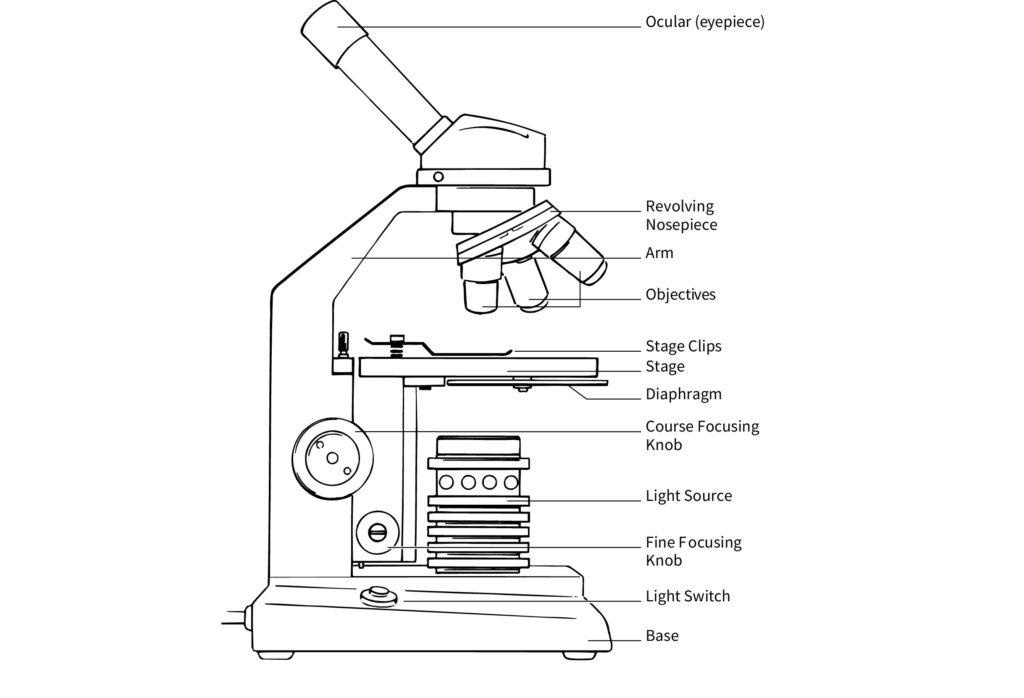
Optical Parts of Compound Microscope
1. Condenser
The condenser of a compound microscope is a lens or system of lenses that is used to focus the light from the light source onto the sample. It is typically located below the stage and is used to control the intensity and distribution of the light and to improve the resolution and contrast of the image.
The condenser serves several important functions:
- It focuses the light onto the sample, which is necessary for the microscope to produce a clear and detailed image.
- It allows the user to control the intensity and distribution of the light, which is important for optimizing the image quality and minimizing glare or reflections.
- To have good resolution at 1000x, you will need a relatively sophisticated microscope with an Abbe condenser.
The condenser is typically located below the stage and is operated using a control knob or lever. The type of condenser and the focusing mechanism used will depend on the design of the microscope and the needs of the user.
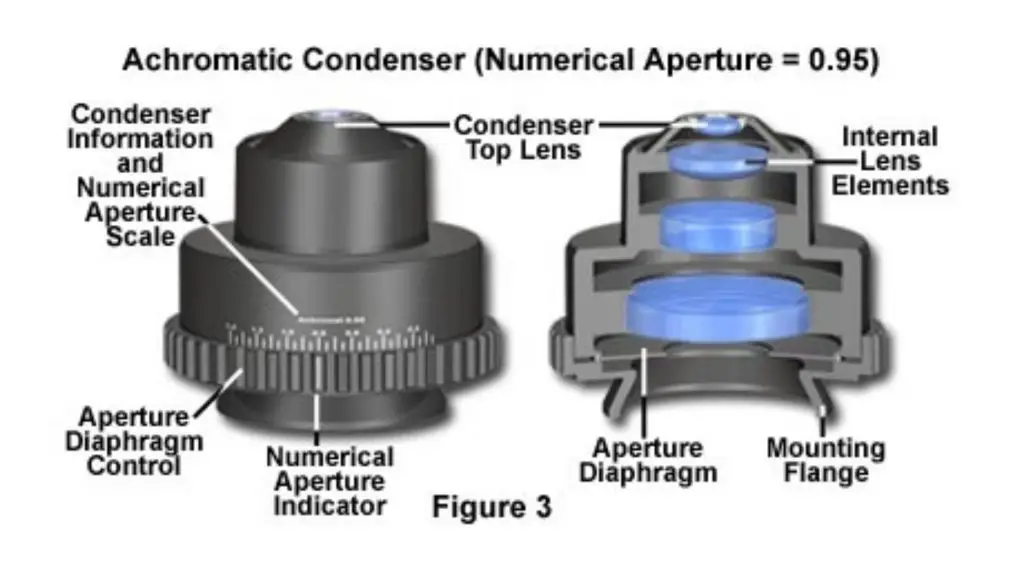
2. Microscope Objective lens
The objective lens of a compound microscope is the lens that is closest to the sample and is used to magnify the image. It is typically mounted on the nose piece of the microscope, which allows it to be rotated and swapped out with other objective lenses to change the magnification of the microscope.
The objective lens serves several important functions:
- It magnifies the image of the sample, which allows the user to see small details and structures that would not be visible to the naked eye.
- It helps to focus the image of the sample, which is necessary for the microscope to produce a clear and sharp image.
- It helps to protect the sample from damage and contamination.
The objective lens is typically made of high-quality glass or other transparent material and is designed to be durable and resistant to damage. It may also have features such as coatings or filters to improve the quality of the image. The most common objective lens magnifications are 4x, 10x, 40x, and 100x.
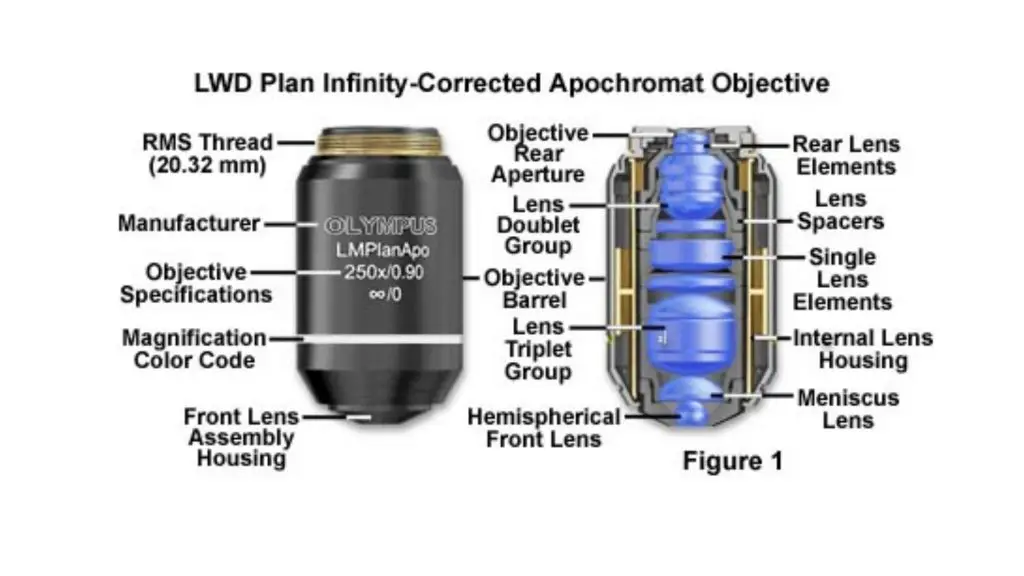
3. Eyepiece
- The eyepieces of a compound microscope are the lenses that the user looks through to view the sample. They are usually located at the top of the microscope head and can be adjusted to fine-tune the focus and magnification of the microscope.
- Eyepieces are usually labeled with their magnification, which is typically 10x or 15x. The total magnification of the microscope is determined by multiplying the magnification of the eyepieces by the magnification of the objective lenses. For example, a microscope with 10x eyepieces and a 40x objective lens would have a total magnification of 400x.
- Eyepieces may also contain additional features such as crosshairs or graticules (finely divided scales or grids) to aid in measuring and observing the sample. Some eyepieces may also have a built-in diopter adjustment, which allows the user to fine-tune the focus for their individual eyesight.
- The eyepieces are mounted in a tube that allows them to be adjusted for the user’s eye distance (interpupillary distance). This helps to ensure that the user’s eyes are properly aligned with the eyepieces and that the image appears sharp and focused.
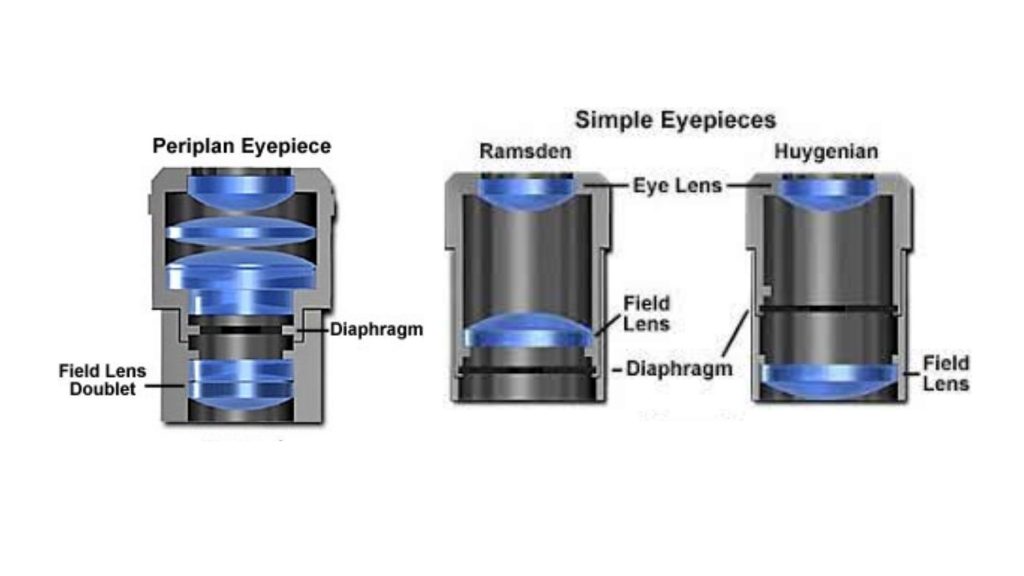
Parts of Compound Microscope Summery
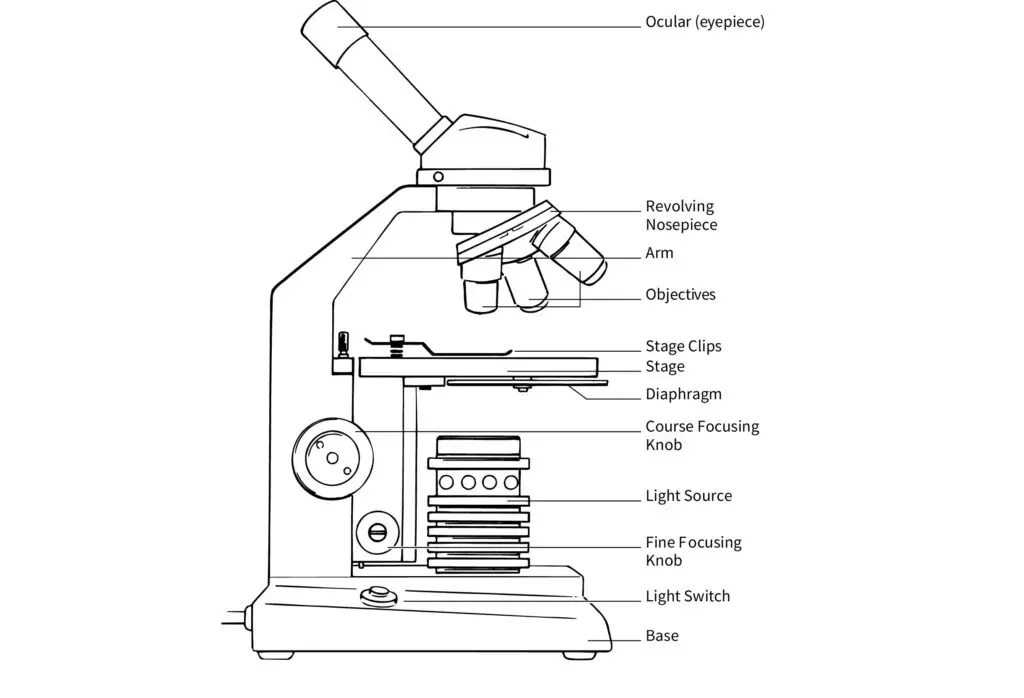
| Term | Definition |
| Coarse Focus | Used in conjunction with the low power goal to locate and focus on a sample. |
| Depth of field | The ability of a lens to provide a picture both above and below the focus plane; depth of field reduces as aperture or magnification increases. |
| Diaphragm | A revolving disc with holes of varied sizes beneath the stage. Regulates how much light may travel through the sample. |
| Field of view | A disc with holes of varied sizes that rotates beneath the stage. Regulates the amount of light that is permitted to enter through the sample. |
| Fine Focus | Used with objects of intermediate and high magnification for modest adjustments to focus. |
| High power | The high-power objective in the microscope’s nosepiece. The aim in the 40X range is typically referred to as the high power objective. If the scope features a 100X oil immersion lens, the 40X objective is not considered the high power objective. |
| Intermediate power | The target with the middle level of force, often 10X. |
| Low power | The target with the lowest power, usually 4X. |
| Magnification | The amount of times a lens system magnifies the size of an object’s image. |
| Parfocal | To achieve focus when rotating from one goal to another, only a minor fine-focus adjustment is necessary. |
| Ocular lens | The nearest lens to the eye; sometimes known as the eyepiece. |
| Objective lens | Any one of the several lenses attached to the nosepiece. |
| Oil immersion lens | A high magnification objective (often 100X) that requires an oil medium to concentrate the maximum amount of light while in focus. |
| Resolving power | The optics’ ability to discern and differentiate fine detail, i.e. two points. |
| Stage clips | Hold the slide in place while viewing. |
Factors play an important role in magnification
There are several factors that play an important role in the magnification of a compound microscope. These include:
- Objective lenses: The magnification of a compound microscope is determined by the power of the objective lenses. Each objective lens has a different magnification power, and using a higher magnification objective lens will result in a higher overall magnification.
- Eyepieces: The magnification of the eyepieces also plays a role in the overall magnification of the microscope. Using eyepieces with a higher magnification will result in a higher overall magnification.
- Focal length: The focal length of the objective lenses and eyepieces also affects the magnification of the microscope. Objective lenses and eyepieces with a shorter focal length will result in a higher magnification, while those with a longer focal length will result in a lower magnification.
- Distance between the objective lenses and the sample: The distance between the objective lenses and the sample also affects the magnification of the microscope. A shorter distance will result in a higher magnification, while a longer distance will result in a lower magnification.
- Distance between the eyepieces and the objective lenses: The distance between the eyepieces and the objective lenses also plays a role in the overall magnification of the microscope. A shorter distance will result in a higher magnification, while a longer distance will result in a lower magnification.
Compound Microscope Resolution Power (Resolving power)
A compound or bright-field microscope’s resolution power (resolving ability) is its ability to distinguish between very close particles. A magnified image should show the object in a larger size. However, it should still have clear details.
This can be achieved when the microscope is able to see two points very close together as two distinct entities. The resolution power is the distance between two objects that can be clearly seen as separate structures in a magnified image.
This explanation is easily understood by comparing it to the human eye. The human eye works on the same principle as a light microscope or bright-field, meaning that objects can be seen by reflecting light.
The human eye has a resolution power of 0.25mm. Two dots placed 0.25mm apart (or more) can be seen only as two dots. Anything closer will appear as a single dot.
Factors that determine Resolution Power
Two factors affect the resolution power of a bright field (light) microscope:
- Wave length of light
- Numerical aperature of the objective.
Wave length of the light
The visible wavelength of light used to illuminate light microscopes (bright field) falls within the visible range (400-750nm). The resolution will increase if the light used is shorter in this range. Blue light, for example, has a shorter wavelength that red light. A blue light can be used as an illumination source to achieve greater resolution than a red one.
The Objective’s Numerical Aperture (NA)
The property of a lens which determines how much light can enter it is called numerical aperture (NA). It is dependent on two factors.
- The medium’s refractive index is the area between the specimen, the front of an objective lens.
- The angle between the divergent rays that pass through the lens and the optical axis is called the angular aperture. The resolution power is greater if the objective can accept more divergent or oblique light.
Numerical aperture (NA) can be mathematically calculated with the help of following formula.
NA = n sin f
Where, n = refractive index of the medium
f = angular aperature
Calculation of Resolution Power of Compound Microscope
The resolution power of a bright-field microscope can be calculated using the following formula:
Resolution (resolving) power (RP) = Wave length of light used for illumination/2 x Numerical aperture (NA)
For convenience, if yellow light of wave length of 580 nm with numerical aperture (NA) of 1.0 is used in the microscope, the resolution power (RP) of the microscope will be:
Resolution power (RP) = 580/2 x 1 = 290 nm
Object Size Measurement by using Compound Microscope
A micrometer can accurately determine the size of objects when they are viewed under a compound microscope. This latter is made up of two scales: the eyepiece scale (also known as ‘graticule or ‘ocular’), and the stage microscope scale. The stage micrometer calibrates the eyepiece scale and then the latter is used to measure.
The microscope eyepiece scale is located inside the microscope eyepiece. The stage micrometer is on the microscope stage. The scale is approximately 1 mm in length and is divided into 100 divisions. Each division is 10 um. The stage micrometer is used for calibrating the eyepiece scale, as mentioned earlier.
(i) Calibration
- It is important to note first which objective lens has been used on the microscope.
- The stage micrometer is placed so that it is visible from the field of vision.
- Rotating the eyepiece so that the two scales, either the eyepiece or the ocular scale, and the stage micrometer, are parallel is a good idea.
- Now, the stage micrometer must be moved so that both scales’ first division marks are in line.
It is now possible to see which divisions of the eyepiece and stage micrometer scale correspond with each other. One division on the stage microscope equals 10 um. This allows one to calculate the value of the eyepiece scale.
The four divisions of the eyepiece stage scale equal 10 divisions (i.e. 100 um) on the stage micrometer scale. 1 division on this eyepiece scale = 25nm for the specific objective lens in this case.
These positions can be repeated with objective lenses. The following information’s are recorded onto an adhesive label. For future reference, adhesive labels are stuck to the base and sides of the microscope.
(iii) Use
After calibrating the eyepiece scales for all objective lenses, the microscope can be used to measure the dimensions and morphology of cells and sub-cellular structures.
Working Mechanism of The Compound Microscope
- Look into the eyepiece. Adjust the mirror so that enough light can pass through the microscope.
- Clean the mirrors, lenses, stage and slides.
- Place the slide in central position on the stage.
- Secure the slide securely with clips along the edges to stop it moving.
- The nose piece can be adjusted so that the low power objective aligns with the object of focal on the slide.
- You can adjust the coarse focus knob upwards or downwards so that the slide remains in focus.
- To get a sharp and clear image of the object in focus, turn the fine adjustment knob upwards or downwards.
- Under low power objectives, all details are captured. The diagrams that are necessary are drawn.
- To align the high power objective with the object, the nose piece must be turned. To get a clear and sharp view of the object, the fine adjustment knob must be adjusted as much as possible.
- High power can be used to observe the details of an object. Make the diagrams. When the object is being examined at high power, the coarse adjustment knob should be avoided as it could crush the slide.
Precautions
The precautions to observe when using a compound microscope are as follows:
Avoid tilting or shaking the microscope while it is in use.
As a result, the light received by the lens is altered, and the object in focus appears differently.
- Prior to targeting the specimen with a high-resolution lens, the specimen must first be focussed with a low-resolution lens.
- The lower power objective lens must be focused on the stage when the compound microscope is no longer in operation.
- The microscope should be lifted using both of its arms and its base.
- The greatest results can be obtained when using an oil immersion lens with oil, as the refractive index can be adjusted without oil and the reading of the specimen can be manipulated.
- Use a clean slide or clean the slide with appropriate water and a clean cloth to prevent stains from being visible under the microscope. Otherwise, it may be difficult for the user to differentiate between a stain and a specimen component.
Applications of Compound microscope
Compound microscopes are widely used in various fields for a range of applications due to their ability to magnify small samples for close observation. Some of the most common applications of a compound microscope are:
- Biology and Medicine: Compound microscopes are extensively used in the fields of biology and medicine for studying the structure and function of cells, tissues, and organisms. They are used to observe microorganisms, blood cells, bacteria, viruses, and other small biological samples.
- Materials Science: Compound microscopes are used to examine the microstructure of various materials, such as metals, ceramics, polymers, and composites. They are used to study the properties of materials, including their morphology, crystal structure, and defects.
- Quality Control: Compound microscopes are used in manufacturing and quality control to examine products and components for defects or imperfections. They are used to inspect printed circuit boards, electronic components, and other products for quality control purposes.
- Education: Compound microscopes are widely used in educational institutions to teach students about the structure and function of cells, tissues, and other biological samples. They are used to conduct experiments and demonstrations in biology and other science courses.
Overall, compound microscopes are versatile tools that are used in a wide range of applications, from scientific research to quality control and education.
Advantages of Compound Microscopes
Compound microscopes are optical instruments that use lenses to magnify objects that are too small to be seen with the naked eye. They are called compound microscopes because they use a combination of lenses to achieve higher magnification than is possible with a single lens. Here are some advantages of compound microscopes:
- High magnification: Compound microscopes can magnify objects up to 1000x or more, allowing you to see very small structures and details. Can magnify up to 2000 times
- Improved resolution: Compound microscopes have a greater resolving power, which means that they can distinguish between objects that are close together. This allows you to see more detail in the sample you are observing.
- Brightfield and darkfield illumination: Most compound microscopes have a light source that illuminates the sample from below, allowing you to see the details of the sample in bright light. Some compound microscopes also have a darkfield illumination system, which allows you to see the sample in a darker field of view, highlighting certain details or structures.
- Easy to Use: This microscope is easy to use.
- Stereomicroscopy: Some compound microscopes have a binocular head, which allows you to view the sample in 3D. This is useful for studying the spatial relationships between different structures in the sample.
- Digital imaging: Many modern compound microscopes have a digital camera or an interface to connect to a digital camera, allowing you to capture images or video of the sample for further analysis or sharing.
Disadvantages Compound Microscope
There are several disadvantages of using a compound microscope:
- Limited field of view: The field of view (the area that can be seen through the microscope) is relatively small, which can make it difficult to see large objects or structures.
- Poor depth of field: The depth of field (the range over which objects are in focus) is also relatively shallow, which means that only a small range of distances from the objective lens will be in focus at any given time.
- Low light levels: Compound microscopes require a lot of light to function properly, and the limited light that is available must be carefully controlled and focused to produce a clear image. This can be a problem when working with samples that are sensitive to light or when working in low-light conditions.
- Vibrations: The movement of the stage (the platform on which the sample is placed) and the focus mechanism can cause vibrations that can affect the quality of the image.
- Cost: Compound microscopes can be expensive, especially high-quality models with advanced features.
- Complexity: Compound microscopes can be complex to operate and maintain, especially for users who are not familiar with their operation.
Stereomicroscope vs Compound microscope
There are several differences between compound microscopes and stereo microscopes:
- Magnification: Compound microscopes typically have a higher magnification range than stereo microscopes. Compound microscopes can magnify samples up to 1000x or more, while stereo microscopes typically have a maximum magnification of around 50-100x.
- Depth perception: Stereo microscopes have a binocular design that allows the user to perceive depth and spatial relationships in the sample. Compound microscopes do not have this capability.
- Illumination: Compound microscopes typically have an internal light source that illuminates the sample from below, while stereo microscopes often have an external light source that illuminates the sample from the side.
- Sample preparation: Compound microscopes typically require samples to be prepared on a microscope slide, while stereo microscopes can often be used with larger, unmounted samples.
- Applications: Compound microscopes are typically used for detailed analysis of small samples, while stereo microscopes are often used for examining larger samples or for tasks that require depth perception, such as dissection or assembly tasks.
What is difference between compound and simple microscope?
A compound microscope is a microscope that uses multiple lenses to produce a magnified image of the specimen being observed. It is the most common type of microscope and is widely used in a variety of settings, including educational, industrial, and research settings. A compound microscope typically has a magnification of 100x or more, and is able to produce a clear, detailed image of the specimen.
A simple microscope, on the other hand, is a microscope that uses a single lens to produce a magnified image of the specimen. It is a less common type of microscope and is typically used for low-magnification applications, such as viewing relatively large specimens or performing basic tasks that do not require high magnification. A simple microscope typically has a magnification of 10x or less, and is not able to produce as clear or detailed an image as a compound microscope.
There are several key differences between compound and simple microscopes:
- Magnification: Compound microscopes have a higher magnification than simple microscopes, typically 100x or more versus 10x or less.
- Lenses: Compound microscopes use multiple lenses to produce the image, while simple microscopes use a single lens.
- Image quality: Compound microscopes produce a clearer, more detailed image than simple microscopes, due to the use of multiple lenses.
- Use: Compound microscopes are used in a wide variety of settings, including educational, industrial, and research settings, while simple microscopes are typically used for basic tasks or for viewing relatively large specimens.
Things to Remember
- Using two sets of lenses, a compound microscope amplifies the image under the microscope.
- The compound microscope contains multiple convex lenses.
- It is equipped with a 4x, 10x, 40x, and 100x objective lens and a 10x eyepiece.
- Compound microscopes are used to view small samples that cannot be seen by the naked eye.
- Typically, under a microscope, these samples are put on a slide.
- The microscope should be lifted using both of its arms and its base.
FAQ
What is compound microscope?
A compound microscope allows users to magnify objects up to 100x magnification. This is great for research work, especially biology. With a microscope, you can view cells, bacteria, viruses, fungi, proteins, DNA, etc.
Who invented compound microscope?
Hans Christian Ørsted was the first person to invent the compound microscope. He used his invention for studying the structure of crystals. His invention helped him win a competition at age 13. After he finished school, he worked at the Royal Observatory in Copenhagen where he got interested in astronomy and optics. Then, he moved to England to work for Thomas Young who was working on diffraction patterns. When Young died, Ørsted took over his position and began using his new invention in 1789. A year later, he published his findings. The microscope became widely popular and changed science forever.
Compound microscope has how many lenses?
A compound microscope has two lenses attached one above the other, which allows users to magnify objects up to 1000 times their actual size. The magnification depends on the distance between the two lenses.
What are zooming microscopes?
A zooming microscope is a microscope that has a continuously variable magnification, typically over a range of about 4x to 50x or more. This is achieved by moving the objective lenses closer to or further away from the sample being observed. Zooming microscopes are also known as varifocal microscopes. They are useful because they allow the user to easily adjust the magnification of the microscope without having to change the objective lenses, which can be time-consuming and inconvenient. They are often used in educational settings, where students may need to observe a variety of samples at different magnifications. They are also used in research and industrial settings where the ability to quickly adjust the magnification can be useful.
What structure does light pass through after leaving the condenser in a compound light microscope?
In a compound light microscope, light passes through the condenser and is focused onto the specimen being observed. The light then passes through the specimen and is focused by the objective lens, which magnifies the image. The magnified image is then passed through the eyepiece, which further magnifies the image and presents it to the viewer.
So, in summary, after leaving the condenser, light passes through the specimen and the objective lens before reaching the eyepiece. The eyepiece is typically located at the top of the microscope, and is the part that the viewer looks through to observe the specimen.
What are fixed power microscopes?
Fixed power microscopes, also known as monocular microscopes or low-power microscopes, are microscopes that have a single, fixed magnification. They are called “low-power” because they typically have a magnification of 10x or less. Fixed power microscopes are simple and inexpensive instruments that are often used in educational settings, such as schools and colleges, to introduce students to microscopy. They are also used in a variety of other settings, including industrial and research laboratories, to perform routine tasks that do not require high magnification.
Fixed power microscopes are typically very easy to use, as they do not have any moving parts or adjustable objective lenses. The user simply places the specimen on the stage and looks through the eyepiece to view the image. Because they have a fixed magnification, fixed power microscopes are not able to produce images at different magnifications. Instead, they are used to observe relatively large specimens, such as insects, plant cells, and other biological specimens, at a low magnification.
What is the field of view of a microscope?
The field of view of a microscope is the area of the specimen that is visible through the eyepiece when looking through the microscope. It is typically measured in millimeters (mm) and represents the width of the viewable area at a particular magnification. The field of view can be adjusted by changing the objective lens or the eyepiece, or by moving the stage up or down.
In general, the higher the magnification of the microscope, the smaller the field of view will be. This is because the objective lens is able to magnify a smaller area of the specimen at higher magnifications. Conversely, at lower magnifications, the field of view will be larger because the objective lens is magnifying a larger area of the specimen. The field of view is an important factor to consider when using a microscope, as it determines how much of the specimen can be seen at any given time.
What is the depth of field of a microscope?
The depth of field of a microscope is the distance between the nearest and farthest points in the specimen that are in focus at a particular magnification. It is typically measured in micrometers (µm) and represents the thickness of the specimen that is in focus. The depth of field can be adjusted by changing the objective lens or the focus knob, or by moving the stage up or down.
In general, the higher the magnification of the microscope, the smaller the depth of field will be. This is because the objective lens is able to focus on a smaller area of the specimen at higher magnifications, and therefore only a thin layer of the specimen will be in focus. Conversely, at lower magnifications, the depth of field will be larger because the objective lens is focusing on a larger area of the specimen and more of the specimen will be in focus. The depth of field is an important factor to consider when using a microscope, as it determines how much of the specimen is in focus at any given time.
What is the focal distance of a microscope?
The focal distance of a microscope is the distance between the objective lens and the point at which it is focused. It is typically measured in millimeters (mm) and is an important factor in determining the magnification of the microscope. The focal distance can be adjusted by changing the objective lens or by moving the stage up or down.
In general, the shorter the focal distance, the higher the magnification of the microscope will be. This is because a shorter focal distance allows the objective lens to focus on a smaller area of the specimen, resulting in a larger magnification. Conversely, a longer focal distance will result in a lower magnification because the objective lens is able to focus on a larger area of the specimen. The focal distance is an important factor to consider when using a microscope, as it determines the magnification of the image that is being observed.
Why is it called compound microscope?
A compound microscope is called a compound microscope because it is made up of multiple lenses, or “compounds,” that work together to produce a magnified image of the specimen being observed. The lenses in a compound microscope include the objective lenses, which are located below the stage and are responsible for magnifying the image, and the eyepieces, which are located above the stage and are responsible for further magnifying the image and presenting it to the viewer.
The term “compound” refers to the fact that the microscope uses multiple lenses to produce the image, rather than just a single lens. This allows for a greater magnification and a clearer, more detailed image than can be achieved with a simple microscope that uses only a single lens. Compound microscopes are the most common type of microscope and are widely used in a variety of settings, including educational, industrial, and research settings.
Reference
- https://www.microscopeworld.com/p-3470-what-is-a-compound-microscope.aspx
- https://www.microscopemaster.com/parts-of-a-compound-microscope.html
- http://www.madsci.org/posts/archives/1999-01/915771165.Gb.r.html
- https://sciencestruck.com/compound-microscope-basics-uses
- https://www.slideshare.net/shrutidhamdhere1/compound-microscope-basic
- https://en.wikipedia.org/wiki/Optical_microscope
- https://www.microscopemaster.com/compound-light-microscope.html
- http://www.funscience.in/study-zone/Physics/OpticalInstruments/CompoundMicroscope.php
- https://www.biologydiscussion.com/microscope/compound-microscope-structure-and-working-principles/5822



The article on the compound microscope is very informative and helpful in understanding the fundamental principles, parts, and applications of this important tool in microbiology. The detailed explanation of each part of the microscope, including the eyepiece, objective lenses, stage, and condenser, is quite helpful in comprehending how the microscope works. The application of the compound microscope in fields such as medicine, biology, and materials science is also well covered in the article. Overall, this article is an excellent resource for anyone seeking to understand the workings and applications of the compound microscope.
Agreed, the objective lens plays a crucial role in producing a magnified image of the specimen in a light microscope. The magnified image produced by the objective lens is further magnified by the eyepiece or ocular lens. It is interesting to note that when higher magnification is required, the objective of higher magnification is aligned with the illuminated portion of the slide by rotating the snout piece. The use of a 100X oil immersion objective lens is particularly helpful when observing bacterial cells. Additionally, the bright-field microscope is so-called because it produces an image within a brightly lit field, where the specimen appears darker due to its greater density and opacity compared to its surroundings.